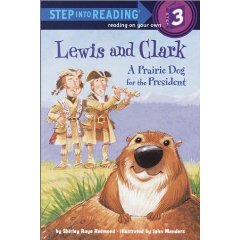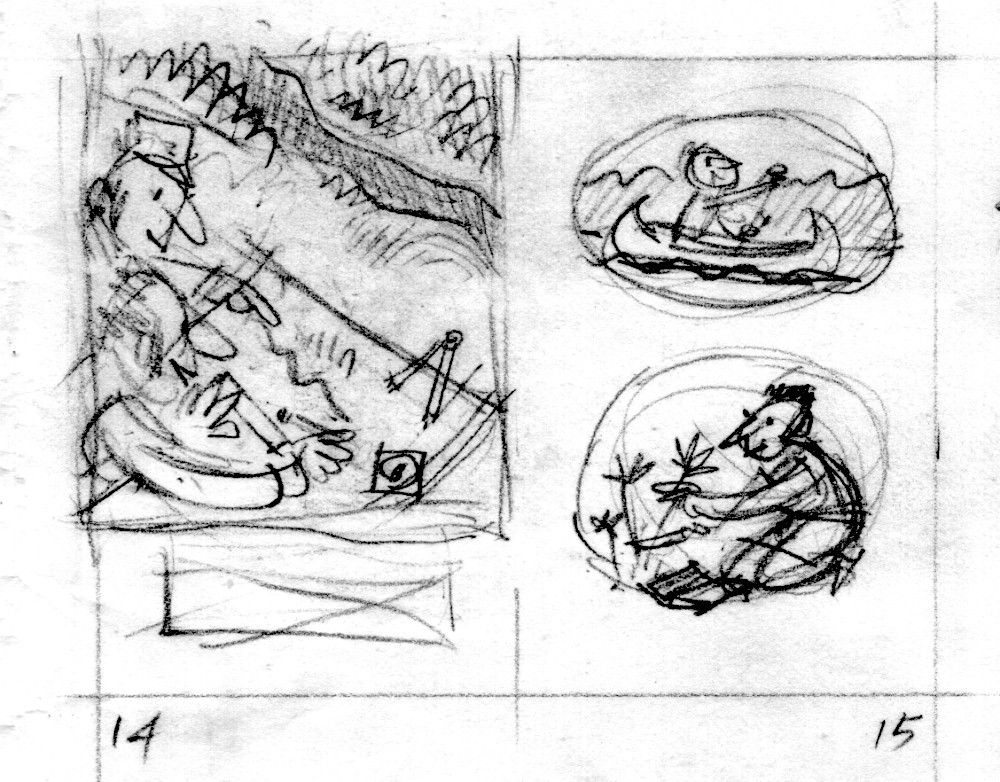Westward, ho!

UPDATE! Ilene, Jerry & Drake discuss digital vs traditional illustration in the comments section below.
I get quite a few historical projects to illustrate, and that suits me fine. I enjoy doing the research—which is crucial to making the costumes and settings authentic.
Here are a few thumbnails, sketches and final paintings from Lewis & Clark, A Prairie Dog For The President. First, a thumbnail sketch of Lewis & Clark making a map—

And here’s the tight sketch. Remember, the thumbnail sketch is pretty small, about an inch-and-a-half tall. My tight sketch is usually half the size of the printed page.

I usually paint at the same size as the image will be printed. The compass in the wooden case shown here belonged to Lewis & Clark.

Here’s another one. The squares with an ‘x’ through them show where the text will go.



This was a fun little book to do. It’s 48 pages long, which is much longer than normal (32 pages). But it’s smaller in size than most picture books.
Below is what I mean by historical costume. I had no reference for Sacajewea, but used a drawing George Catlin had made of a young woman from Sacajewea’s tribe thirty years after her adventure with Lewis & Clark.

Here’s a comp (short for comprehensive layout) of the book’s cover. It shows the type and the sketch together. The next step is for me to paint the sketch portion.




What a fun job! I wish I could get work like this!
While it took me 2 years to read the journals of Lewis and Clark solely on the toilet, I found them to be pretty fascinating. Good bathroom reading!
This is really nice! A fun and colorful illustration.
Fun stuff, John! You work in gouache, correct?
Yup! I like gouache because it’s versatile. If a client needs something changed on a painting, I can soak off the paint from that area and redo it. The change isn’t obvious because gouache is opaque.
Great post, John.
Unfortunately, I see most book illustration these days being done digitally… did you have to talk your publisher out of digital format, or did they leave it up to you?
There are still quite a few of us illustrating the old-fashioned way. Many illustrators these days do a fusion of traditional painting and digital enhancement. My agent takes my samples around and the art directors know I paint traditionally. The production houses who handle children’s books are equipped to handle either format.
Drake,
Why is it unfortunate?
I work both ways. Often, I mix the two.
Check out my work. (click on my name)
…spelled my own name wrong in the previous post . My “L” key is sticky.
Thanks for the response, John. Glad to hear it.
Jerry, to me it’s unfortunate because for children’s books especially, digital paintings often lack the charm and character of traditional paintings. There are a few exceptions of course, but much of it has no personality or soul. Today’s cheaper printing methods and flimsy paper aren’t helping either.
Don’t get me wrong, I also paint both ways (usually separately) and I think digital has its place… I guess I just wish it weren’t relied on so heavily in the children’s book market.
I hear you loud and clear. To me, digital is just another tool. To some, it’s a crutch, and you’re right on the mark — a lot of it lacks any character or concept (or talent in a lot of cases). I used to teach a design class at a local college, and taught their first ever desktop publishing class. When I’d introduce an assignment in either class, I’d forbid the students to use the computers until they had worked out several solid ideas in their sketchbooks. Too easy to slap some type on a page, add a drop shadow and call it done. Unfortunately (there’s that word again) there’s far too much of that kind of “design” going on.
John- you blog like you teach; beautiful and clear with the mix of humor and irony that only a master can summon. And that’s not just because you’re my friend. As to the comments above, I can’t argue long enough in favor of keeping our ‘hands’ in our art. It’s why, when asked to fill in the ‘media’ space in an exhibit form, I usually say ‘tra-digital’, to let folks know there’s still some of me in the image! Here’s the thing; if we allow our manual skills to atrophy, we become servants of technology instead of the other way around.
Oh, Ilene— *blush!*
I remember Dave DiBella at Art Institute of Pittsburgh telling me about the time Disney sent talent scouts to look over the grads’ portfolios. They weren’t interested in computer skills as much as draftsmanship. Their rationale was that anyone can learn a software program in a few weeks but it takes years to learn to draw well.
Here’s an article I wrote on the subject of digital art:
http://tinyurl.com/y96ue7t
“… here’s an article I wrote …” after I submitted, it looked too self-promotional for another person’s blog, but there’s no way to delete it. Really just expanding on the discussion. I wrote it several years ago after someone described some of my work as “computer generated”.
Not at all, Jerry. My blog is for young people who are interested in illustration. Any information you can bring is appreciated!